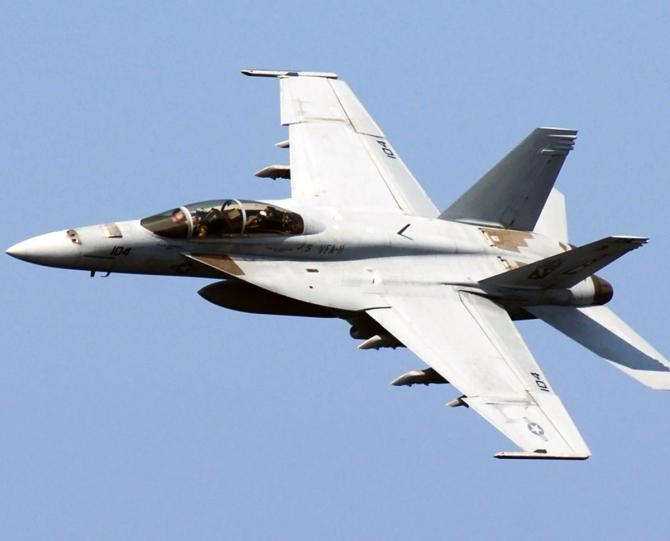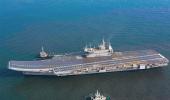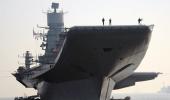The Indian Navy has decided that the twin-seat Rafale will not be disqualified on the basis of its inability to operate from an aircraft carrier, reports Ajai Shukla.

The Indian Naval Ship Vikrant, the Indian Navy's first indigenous aircraft carrier (IAC-1), is undergoing lengthy sea trials, after which it will enter operational service late this year.
With the 45 Russian MiG-29K/KUB fighters notorious for their unreliability, the navy plans to urgently procure 26 multi-role carrier-borne fighters (MRCBF) from an international vendor, so that INS Vikrant has more strike options besides the unreliable MiG-29s.
With INS Vikrant likely to be followed by a second indigenous aircraft carrier (IAC-2) named INS Vishal, another 31 MRCBFs will be acquired to operate off its deck, taking the MRCBF acquisition to 57 fighters.
The Boeing Company, the leading contender to supply the MRCBFs, says the F/A-18E/F Super Hornet fighters it is offering are significantly more attractive than the carrier-borne Rafale variant -- the Rafale Marine -- which French company, Dassault Aviation, is offering.
Alain Garcia, Boeing Defense's business development chief in India, says the Super Hornet offers major operational advantages. The Indian Navy's tender for 26 MRCBFs requires eight twin-seat and only 18 single-seat variants.
That is not a problem for Boeing, whose F-18s are all designed -- the single-seat F/A-18E and the twin-seat F/A-18F -- to be capable of carrier-deck operations.
In contrast to the twin-seat Super Hornet, the twin-seat Rafale Marine cannot operate off an aircraft carrier. Many Indian acquisition officials argue that this should disqualify the twin-seat Rafale from the MRCBF tender.
"Eight of the 26 Rafale fighters being bought can operate from land bases only. It is hard to understand why the navy would buy jets that cannot operate off a carrier," said an Indian procurement official.
But sources say the Indian Navy has decided that the twin-seat Rafale will not be disqualified on the basis of its inability to operate from an aircraft carrier.
Boeing officials argue that the Super Hornet is designed from ground-up as a carrier-borne aircraft with every component designed to that end. For example, the Super Hornet's foldable wings saves space on the flight deck, the hangars and on the lift that transports aircraft between these two levels.
In contrast, the Rafale's wings are not foldable. Parts must be removed -- such as nose cone and wing tips -- to move it from one deck to another.
Like the Super Hornet, other platforms and aviation systems that operate off a US carrier are designed from ground-up to function as part of a carrier-based system. For example, the electronic attack variant of the Super Hornet, called the F/A-18G Growler, are designed to accompany the Super Hornets on strike missions, jamming enemy radar and electronic defences.
US Navy aircraft carrier groups also have an airborne early warning capability in their air wings, for which each carrier embarks three-four E-2D Hawkeye aircraft. The Indian Navy is weighing having this capability.
Carrier-borne Super Hornets are also highly compatible with equipment that the Indian Navy already operates. They are connected over NATO standard Link-16 data, voice and video links with the MH-60 Romeo anti-submarine helicopters, P-8I Poseidon long-range maritime aircraft and with the other warships in the carrier group.
If the Indian Navy acquires Super Hornets, inter-operability would be further enhanced between US navy platforms.

New acquisition process
The method chosen for selecting the MRCBF is different from the defence ministry's standard procurement process and will reduce the time taken for evaluating, selecting and contracting for the aircraft.
The process began with the navy issuing a request for Information (RFI), to which Boeing and Dassault responded.
Then both aircraft -- the Super Hornet and the Rafale Marine -- carried out an operational demonstration in the navy's shore-based test facility (SBTF) in Goa to demonstrate their aircraft's compatibility with a ski jump and other carrier systems.
Now both firms will submit a final letter of price and availability and Indian officials will make a decision based on that.
Indian Navy pilots will not fly the aircraft. Instead, the defence ministry will evaluate the operational demonstration and prepare a technical evaluation report, based on that.
Boeing complains that the RFI is based on the lowest common denominator, in which the lowest priced aircraft is chosen rather than the most capable one.
With only two competitors in the fray, the Indian Navy wants to keep both of them in consideration to avoid a single-vendor competition. That keeps the navy writing and adjusting requirements to keep both competitors in.











